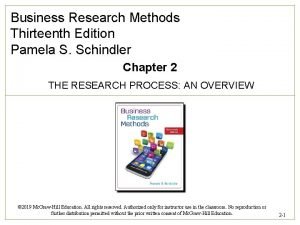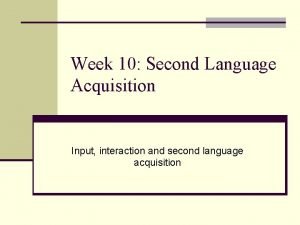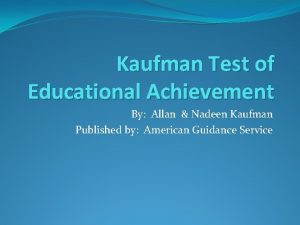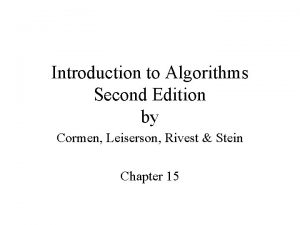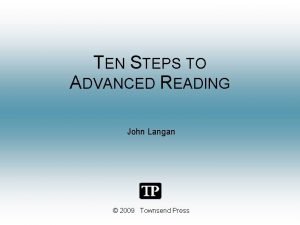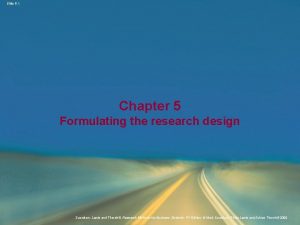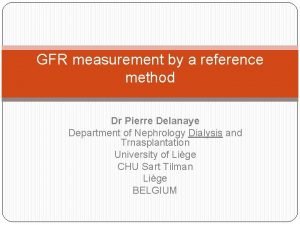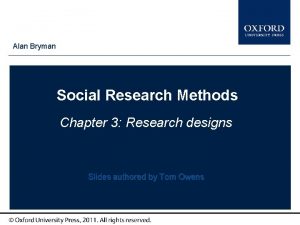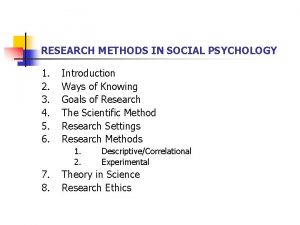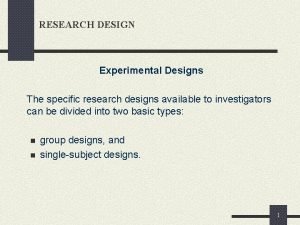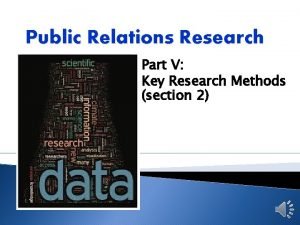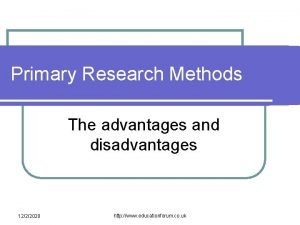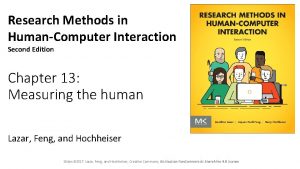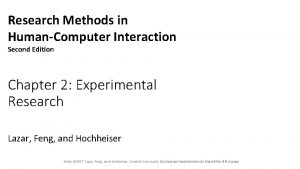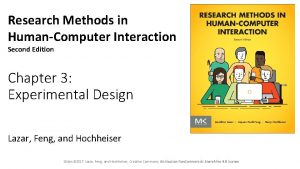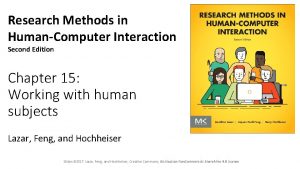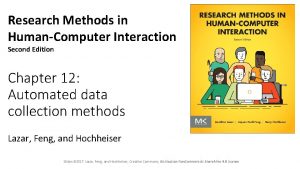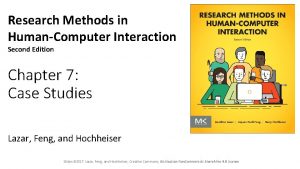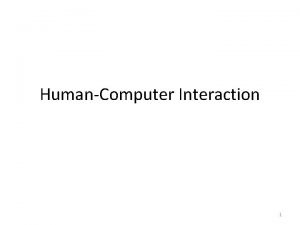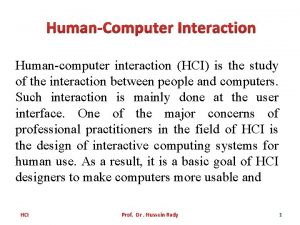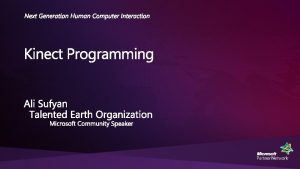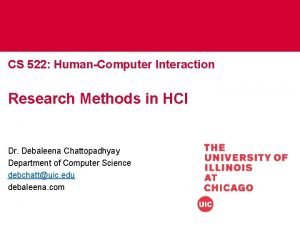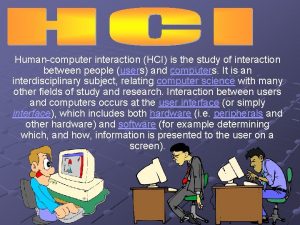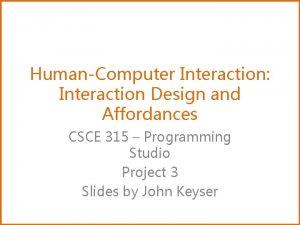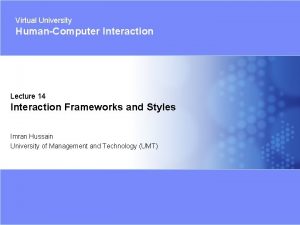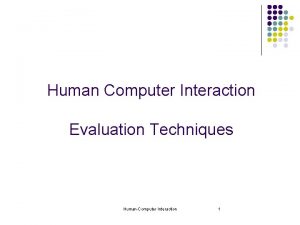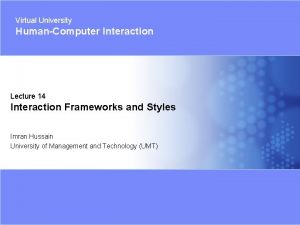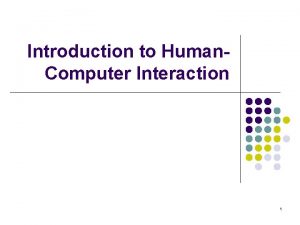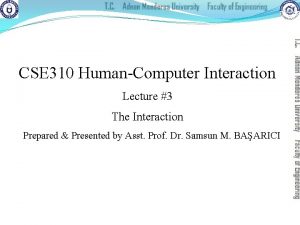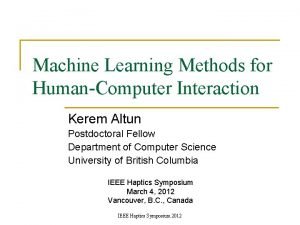Research Methods in HumanComputer Interaction Second Edition Chapter





























- Slides: 29

Research Methods in Human-Computer Interaction Second Edition Chapter 8: Interviews and Focus Groups Lazar, Feng, and Hochheiser Slides © 2017 Lazar, Feng, and Hochheiser, Creative Commons, Attribution-Non. Commercial-Share. Alike 4. 0 License

Ask the users • Direct conversations as tools for data collection • Understand requirements, needs, problems • Interviews – one at a time • Focus groups – many Slides © 2017 Lazar, Feng, and Hochheiser, Creative Commons, Attribution-Non. Commercial-Share. Alike 4. 0 License

Pros/cons of interviews & focus groups • Pros • Go deep • Flexible • Cons • Skill to manage • Time and resource intensive • Recall problems Slides © 2017 Lazar, Feng, and Hochheiser, Creative Commons, Attribution-Non. Commercial-Share. Alike 4. 0 License

Applications of interviews • Initial exploration • Requirements elicitation • Evaluation and Subjective Reactions Slides © 2017 Lazar, Feng, and Hochheiser, Creative Commons, Attribution-Non. Commercial-Share. Alike 4. 0 License

Who to interview • Beyond users – Stakeholders • Anyone who may be affected by the use of a system • Interview representatives of different groups from different perspectives • Key informants: particularly useful/informative individuals Slides © 2017 Lazar, Feng, and Hochheiser, Creative Commons, Attribution-Non. Commercial-Share. Alike 4. 0 License

Types of Interviews Fully Structured Semi-Structured Unstructured Less structure: greater difficulty in conducting and interpreting interview But More opportunity for insight Slides © 2017 Lazar, Feng, and Hochheiser, Creative Commons, Attribution-Non. Commercial-Share. Alike 4. 0 License

Comparing the types • Fully structured – Orally-presented survey • Stick with the script • Good for comparison across individuals • Semi-structured • pre-specified questions • starting point for discussion • Digression is ok Slides © 2017 Lazar, Feng, and Hochheiser, Creative Commons, Attribution-Non. Commercial-Share. Alike 4. 0 License

Comparing the types • Unstructured – initial question, possible list of topics, but no pre-defined script • Less structure good for open ended exploration Slides © 2017 Lazar, Feng, and Hochheiser, Creative Commons, Attribution-Non. Commercial-Share. Alike 4. 0 License

Focused & contextual interviews • Go beyond asking questions • Ask participant to • Demonstrate use of technology • Show artifacts (papers, photos, etc. ) • React to “probes” - props or prototypes designed to elicit reaction Slides © 2017 Lazar, Feng, and Hochheiser, Creative Commons, Attribution-Non. Commercial-Share. Alike 4. 0 License

Interviews vs. focus groups • Interviews take time • Often 1 hour or more/response • Several hours for analyzing notes • Focus groups • More people in less time • Up to 8 -12 people at once Slides © 2017 Lazar, Feng, and Hochheiser, Creative Commons, Attribution-Non. Commercial-Share. Alike 4. 0 License

Focus groups: pros and cons • Pros • Broad range of viewpoints and insights • Each group will likely have at least one person who will stimulate others to talk • Cons • • Hard to manage group dynamics Generally can't be fully structured May need to ask fewer questions Selection can be challenging Slides © 2017 Lazar, Feng, and Hochheiser, Creative Commons, Attribution-Non. Commercial-Share. Alike 4. 0 License

Closed-ended questions • Specific answers • “On a scale of 1 -10, 10 being best, how did you like the web page? ” • Yes/No • Easy to analyze, but may not be informative Slides © 2017 Lazar, Feng, and Hochheiser, Creative Commons, Attribution-Non. Commercial-Share. Alike 4. 0 License

Open-ended questions • “What did you think about the web page? ” • Invite elaboration, discussion • Ask users to complete a sentence • “My favorite web browser feature is. . . ” • Conceptual mapping • Draw pictures or layouts to describe understanding of a situation or problem Slides © 2017 Lazar, Feng, and Hochheiser, Creative Commons, Attribution-Non. Commercial-Share. Alike 4. 0 License

Other guidelines • Simple questions – no jargon • Avoid compound questions with multiple parts • Not "“What were the strengths and weaknesses of the menu layout and the toolbar? ” • Ask two separate questions instead. • Or four… • Avoid judgmental phrasing or tone • Possible bias Slides © 2017 Lazar, Feng, and Hochheiser, Creative Commons, Attribution-Non. Commercial-Share. Alike 4. 0 License

Un- or semi-structured interviews • Often, questions are generated in response to participant comments • Can be hard to do this well • Start with more highly-structured interviews • Get a few under your belt before moving to unstructured Slides © 2017 Lazar, Feng, and Hochheiser, Creative Commons, Attribution-Non. Commercial-Share. Alike 4. 0 License

Preparing for interviews • Pilot test – w/ colleagues and participants • Good for logistics and for confidence • Write an interview guide listing what to do and when • Particularly good if multiple researchers are involved • Logistical backups • Batteries for laptop, audio recorder, extra paper, etc. Slides © 2017 Lazar, Feng, and Hochheiser, Creative Commons, Attribution-Non. Commercial-Share. Alike 4. 0 License

Notes • Audio and video recordings are fine. . • But, paper notes are still important • Record insights, non-verbal responses, etc. • Try to record what you can, but • Don't do so at the expense of listening • Summarize written notes as soon as possible after the interview • before you forget. . . Slides © 2017 Lazar, Feng, and Hochheiser, Creative Commons, Attribution-Non. Commercial-Share. Alike 4. 0 License

Recordings • Complete, but expensive • Transcription can take many hours • Video is tricky, but gets useful information • Consider audio + still pictures • Respect privacy and anonymity • Have a consistent policy for comments made after the notebook is away and the recorder is off • Ok to restart, but be consistent about it Slides © 2017 Lazar, Feng, and Hochheiser, Creative Commons, Attribution-Non. Commercial-Share. Alike 4. 0 License

During the interview • You're the host: • build rapport • Be friendly, respectful, nonjudgmental • Listen carefully • Outline • Briefly introduce research goals • Complete paperwork (informed consent) • Simple questions first, hard questions later Slides © 2017 Lazar, Feng, and Hochheiser, Creative Commons, Attribution-Non. Commercial-Share. Alike 4. 0 License

During the interview, continued • Be flexible • If your interview is not fully structured • But, try to keep things on track • Explain why you are asking each question • Define terms, avoid jargon • Ask for clarification Slides © 2017 Lazar, Feng, and Hochheiser, Creative Commons, Attribution-Non. Commercial-Share. Alike 4. 0 License

Read between the lines • Is the interviewee telling you what they think you want to hear? • If so, make a note of it • Might want to downplay in interpretation Slides © 2017 Lazar, Feng, and Hochheiser, Creative Commons, Attribution-Non. Commercial-Share. Alike 4. 0 License

Challenges of focus groups • Manage the room. Be prepared to deal with • Digressions • Arguments • Give everyone a chance to talk • Address them directly • “Joan, what do you think about. . . ? ” Slides © 2017 Lazar, Feng, and Hochheiser, Creative Commons, Attribution-Non. Commercial-Share. Alike 4. 0 License

Promoting discussion • What if they won't talk? • Fully-structured – not much to do • Otherwise • Rephrase questions • Dig deeper into specifics • Use props and probes to stimulate feedback • Focus groups – ask for dissenting or concurring feedback Slides © 2017 Lazar, Feng, and Hochheiser, Creative Commons, Attribution-Non. Commercial-Share. Alike 4. 0 License

Specialized types of focus groups • Numerous techniques for more structured focus groups • Example: Nominal Group Technique • Respondents provide candidate answers to clear, focused question • Rate responses and iterate to generate prioritized list of answers Slides © 2017 Lazar, Feng, and Hochheiser, Creative Commons, Attribution-Non. Commercial-Share. Alike 4. 0 License

Closing it out • Ask for any final comments • Provide more detail about research goals • Brief summary of findings • Turn off recording devices • Interviewees might make additional useful comments • Ask before including these comments in analyses • Say “thanks!” • Reflect and summarize notes immediately Slides © 2017 Lazar, Feng, and Hochheiser, Creative Commons, Attribution-Non. Commercial-Share. Alike 4. 0 License

Telephone or online • Phone, web chat, email, conference calls • Pros • Easy, inexpensive • Reach more people with less effort • Potentially powerful screen, audio capture • Cons • Lack of face-to-face contact • Fewer non-verbal cues • Pacing can be harder Slides © 2017 Lazar, Feng, and Hochheiser, Creative Commons, Attribution-Non. Commercial-Share. Alike 4. 0 License

Data analysis • Do it as soon as possible • Sit down and summarize notes immediately afterward • Avoid “cherry-picking” • Fully-structured, closed-ended: tabulate answers • Open-ended questions require qualitative coding • Transcribe audio • Written summaries Slides © 2017 Lazar, Feng, and Hochheiser, Creative Commons, Attribution-Non. Commercial-Share. Alike 4. 0 License

Qualitative analysis • Content analysis – frequency of terms, patterns in the notes • Categorization • Affinity Diagrams • Critical-incident analysis • Multiple analyses can increase validity • See Chapter 11 for more details Slides © 2017 Lazar, Feng, and Hochheiser, Creative Commons, Attribution-Non. Commercial-Share. Alike 4. 0 License

Reporting results Be as specific as possible • • • not “most respondents” Instead, “ 7 out of 10 respondents” Use quotes or paraphrases from respondents • • • But don't use participant name use identifiers (Subject 3) or pseudonyms Slides © 2017 Lazar, Feng, and Hochheiser, Creative Commons, Attribution-Non. Commercial-Share. Alike 4. 0 License
 Pamela schindler
Pamela schindler Input interaction and second language acquisition
Input interaction and second language acquisition 186 282 miles per second into meters per second
186 282 miles per second into meters per second Advanced word power second edition answers
Advanced word power second edition answers Accounting principles second canadian edition
Accounting principles second canadian edition Accounting principles second canadian edition
Accounting principles second canadian edition Accounting principles second canadian edition
Accounting principles second canadian edition Clear thinking and writing
Clear thinking and writing Accounting principles second canadian edition
Accounting principles second canadian edition Kaufman test of educational achievement scores
Kaufman test of educational achievement scores Introduction to algorithms 2nd ed
Introduction to algorithms 2nd ed In company second edition
In company second edition Wechsler individual achievement test second edition
Wechsler individual achievement test second edition Ten steps to advanced reading answer key
Ten steps to advanced reading answer key Organic chemistry second edition david klein
Organic chemistry second edition david klein Mis chapter 6
Mis chapter 6 Report
Report Research methods for business students chapter 5
Research methods for business students chapter 5 Reference methods 18th edition
Reference methods 18th edition Wax pattern fabrication
Wax pattern fabrication The fundamentals of political science research 2nd edition
The fundamentals of political science research 2nd edition Alan bryman
Alan bryman Research methods notes
Research methods notes Research methods in social psychology
Research methods in social psychology Research methods in developmental psychology
Research methods in developmental psychology What is time dimension in research
What is time dimension in research Research design example
Research design example Public relations research methods
Public relations research methods Primary research methods advantages and disadvantages
Primary research methods advantages and disadvantages Examples of quantitative research questions and hypotheses
Examples of quantitative research questions and hypotheses
